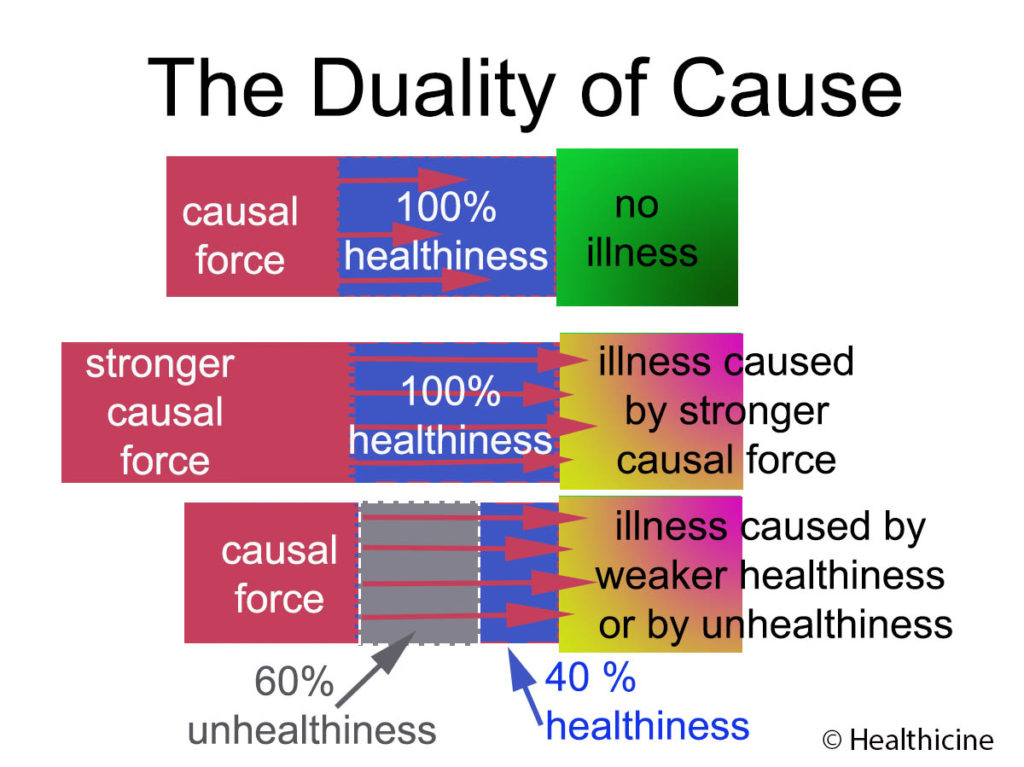When aiming to cure any illness, we focus our attention on cause. Cause and effect is a metaphysical problem for philosophers, who continue to argue, after centuries of debate, about its existence, or non-existence. The problem is simpler with regards to cures. When we cure an illness by understanding the cause, we prove that cause. We might be wrong, but a cure is a cure! Of course, living entities use cause and effect for many purposes, to create and maintain life, to live, to grow, to reproduce, and to evolve. Most causes produce healthiness, not illness.
When working to address a cause to provide a cure, we must always be aware of and attend to the Duality of Cause. Every cause has two sides. As a result, and two ways to cure.
There are two situations where a causal force can result in an illness.
- A causal force can result in an illness when it is stronger than the entity’s healthiness with regards to that force. We jugge this illness as caused by an external force. Note: A cause external to an illness might still be internal to the life entity. Life consists of many layers, from genetics to cells to tissues, limbs and organs, organ systems, body, minds, spirits, and communities. Each layer is an external environment for all lower layers in the hierarchy.
- A causal force can also result in an illness when the life entity’s healthiness is weaker, with regards to a causal force. This is an illness caused by a lack of healthiness.
Let’s look at a simple example, an injury illness: a broken leg.
Illness #1: Injury
One person might suffer a broken leg due to a force on the leg. Another person might only suffer a bruise from the same force when the healthiness of their leg is stronger. We can judge the broken leg to be caused by the force if it is sufficient to cause a broken leg in a person with normal health.
Illness #2: Unhealthiness Leading to Injury
Another person might suffer a broken leg due to a minor stress, a stress that would not break the bone of a person with normal levels of healthiness. Perhaps even a force so small that it would not seriously bruise someone with normal levels of healthiness. In this case, the illness is caused – not by the force – but by a lack of healthiness. We might even judge that although the broken leg is the urgent illness, it is not the most important illness. Unless the unhealthiness of the patient is addressed, more broken legs will occur.
Every cause of every illness has this dual nature, where the force of the illness cause meets the healthiness of the patient. Every cause can cause an illness when it is stronger than the health of a normal person, but will not cause any illness if the causal force is below the level of normal healthiness.
A person whose level of healthiness is far below normal will suffer more illnesses and more severe illnesses caused by lesser stresses, by forces that do not cause illness in most persons.
From the perspective of signs and symptoms, the two illnesses might appear identical. A broken leg is a broken leg. In these examples, they are different, because they need different cures.
From the perspective of a cure, each illness has a different cause because it requires a different cure. If the illness is an injury, a broken leg, then only cure is healing. The cause is gone. In the second case, the illness is complex. There are two illness elements. Healing the broken leg is important, but not a total cure. The only cure that will stick is to address the weakness in healthiness. Addressing the causal force might prevent further illness, but only on a temporary basis.
Every cause has two sides. When we only treat signs and symptoms, this knowledge is of little consequence. When we wish to produce cures – it is essential to cure success and to being aware of our cure successes.
Chronic Illness: Chronic Causes
Chronic illnesses have chronic causes. Chronic causes are more likely to be unhealthiness causes. Most non-injury illnesses are caused by unhealthiness, not by external forces. When unhealthiness persists, it becomes chronic leading to chronic illness that waxes and wanes as the inverse of the unhealthiness.
An infection might be a single incident, caused by a chance encounter with a bacteria, perhaps entering a wound. When we cure with an antibiotic, we perceive the bacteria to be the cause.
But a chronic infection has a different cause. It might be the unhealthiness of a patient, of their job, of their home, or some other environmental factor that creates infections again and again. The chronic infection cannot be cured with medicine, it can only be cured with health – by addressing the cause with healthiness.
Understanding Cause
Understanding the duality of cause makes us aware of more opportunities to cure. Whenever we find a cause of an illness, we can always find a cause of the cause, and a chain of causes. We can find a consequence of each cause in the chain – consequences that occur before the signs and symptoms are other causes in the chain. Every cause and every effect is a part of a cause and effect pair, where every effect becomes a new cause.
The only solo-cause is a fake cause – the placebo cause. Placebo causes cannot lead us to cures. Causes are never single, they are fractal. The closer we look, the longer the chain. When the causal chain is correctly identified, we can cure the illness by successfully addressing any link in the chain. There are many possible cures to address each link, often the only limit is our imagination.
For example, someone might be suffering from scurvy because they are working on a ship that provides a faulty diet because the cook doesn’t know much about nutrition. We can cure the illness by getting the patient off of the ship – the first link. We might also cure by addressing the cook’s lack of knowledge. We might replace the cook, or teach the cook about nutrition, or perhaps establish set menus for the cook to use. Of course, if the scurvy has caused severe symptoms, the sailor will also need supplemental Vitamin C to aid healing processes. Note: None of the actual cures is a medicine.
However, we might find that training the cook and providing set menus do not cure. How can this happen? If the sailor does not like the foods provided to supply Vitamin C – the illness will continue. In this case, the cause is internal to the sailor, not external to the diet provided by the ship’s cook.
Cure Cause
Which cause is most important? The one that cures. Once an illness is cured – debates are pointless. What do we call the cause that leads to a cure? The cure cause.
 This post is based on the concepts of curing as published in the book The Elements of Cure.
This post is based on the concepts of curing as published in the book The Elements of Cure.
to your health, tracy
ps. It is interesting, to note that three major medical references: Merck Manual of Diagnosis and Therapy, Harrison’s Principles of Internal Medicine, and Lange’s Current Medical Diagnosis and Treatment each provide recommendations to “treat” scurvy, but none uses the word cure, and none recommends a treatment that can cure. Scurvy, it seems, is incurable according to the authoritative medical references. Why not? Because the true cure is not a medicine.



